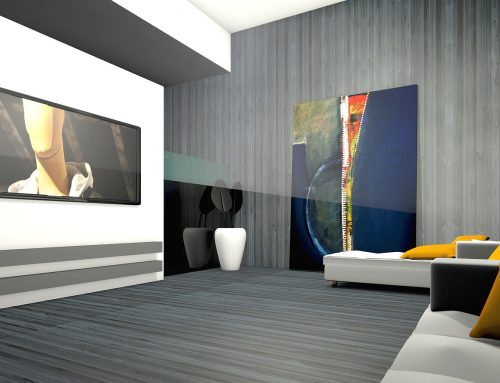Einsteigerguide: Was ist React 360?
React 360 ist ein Framework zur Erstellung von 3D- und VR-Benutzeroberflächen. React 360 basiert auf React – einer Bibliothek, die die Erstellung komplexer Benutzeroberflächen vereinfacht – und ermöglicht es Ihnen, vertraute Tools und Konzepte zu verwenden, um immersive 360-Inhalte im Web zu erstellen.

Wozu ist es gut?
React 360 ist optimiert für die Erstellung von Benutzeroberflächen, die Multimedia-Erlebnisse ermöglichen. Es bietet die notwendigen Werkzeuge zur Erstellung hochwertiger Schnittstellen und bildet eine solide Grundlage für Anwendungen, die auf 360er und 3D-Inhalten basieren. Die in React 360 verwendeten Techniken und Tools ähneln denen von Oculus und Facebook bei der Entwicklung ihrer VR-Anwendungen für Desktop und Mobile und sind das Ergebnis jahrelanger Forschung nach Best Practices.
Bei React 360 geht es darum, Interaktivität in 360 Grad Räume zu bringen. Anwendungen, die 2D- oder 3D-Schnittstellen kombinieren, sind leicht zu erkennen. Foto- und Videobetrachter, 360 Grad Touren, klassische Abenteuerspiele und 3D-Brettspiele sind Beispiele für Dinge, die bisher mit React 360 erstellt wurden.
Inwiefern unterscheidet sich React 360 von React VR?
Anfang 2017 veröffentlichten Facebook und Oculus eine JavaScript-Bibliothek mit der Bezeichnung „React VR“, die für die Erstellung von 3D- und VR-Erlebnissen im Webbrowser entwickelt wurde. Gleichzeitig begann Oculus mit der Verwendung einer nativen C++-Version des Frameworks, um eigene First-Party-Anwendungen zu entwickeln. Im Laufe der Zeit divergierten die APIs der beiden Projekte, da sich das Entwicklerteam von Facebook mit den unterschiedlichen Bedürfnissen der Rahmenbedingungen auseinandergesetzt haben. Um Verwechslungen zwischen den beiden Systemen zu vermeiden, wurde das Open-Source-Framework in „React 360“ umbenannt, was seinen Anwendungsfall besser widerspiegel: die Erstellung von immersiven 360-Grad-Erlebnissen, die über PC-, Mobile- und VR-Geräte genutzt werden können.
Wenn Sie zuvor React VR verwendet haben, sollten Sie feststellen, dass React 360 sehr ähnlich ist. Es wurden viele der gängigsten Workflows vereinfacht, wie z.B. das Platzieren von 2D-UI-Elementen im 3D-Raum und die Leistung für diese Anwendungsfälle optimiert. Wenn Sie eine ältere React VR-Anwendung für die Verwendung der neuen Tools migrieren möchten, folgen Sie dieser Anleitung.
Inwiefern unterscheidet sich React 360 von A-Frame?
A-Frame ist ein Framework zum Aufbau von VR-Welten mit deklarativen HTML-ähnlichen Komponenten. Es verfügt über eine umfangreiche Sammlung von verfügbaren Komponenten aus einer lebendigen Community und eignet sich hervorragend für die Erstellung komplexer 3D-Szenen, die in VR betrachtet werden können. Es kann davon ausgegangen werden, dass React 360 einen anderen Anwendungsfall abdeckt, der für Anwendungen optimiert ist, die auf Benutzeroberflächen basieren oder ereignisgesteuert sind.
Versuchen Sie herauszufinden, welches Framework für Sie das Richtige ist? Hier finden Sie einen Kurztest. Wenn ihre Anwendung durch Benutzerinteraktion gesteuert wird und über viele 2D- oder 3D-Oberflächenelemente verfügt, bietet React 360 die Tools, die Sie benötigen. Wenn Ihre Anwendung aus vielen 3D-Objekten besteht oder auf komplexe Effekte wie Shader und Nachbearbeitung angewiesen ist, erhalten Sie von A-Frame besseren Support. So oder so, Sie werden großartige, immersive Erfahrungen machen, die VR-fähig sind.
Inwiefern unterscheidet sich React 360 von Three.js?
Three.js ist eine Bibliothek für das 3D-Rendering im Webbrowser. Es ist ein viel facettenärmeres Tool als React 360 und erfordert die Kontrolle über rohe 3D-Meshes und Texturen. React 360 wurde entwickelt, um einen Großteil davon vor Ihnen zu verbergen, es sei denn, es wird benötigt, so dass Sie sich auf das Verhalten und das Aussehen Ihrer Anwendung konzentrieren können.
Derzeit verlässt sich React 360 bei einigen seiner Renderingarbeiten auf Three.js. Es werden jedoch die entsprechenden APIs geöffnet, so dass React 360-Entwickler in Kürze die 3D-Rendering-Bibliothek ihrer Wahl verwenden können, einschließlich roher WebGL-Aufrufe.
Wir hoffen, dass wir Ihnen einen kurzen Einstieg in die Arbeit mit React 360 bieten konnten. Wenn Sie Fragen oder Anregungen haben sollten, hinterlassen Sie uns unten einen Kommentar.
Vielen Dank für ihren Besuch.


